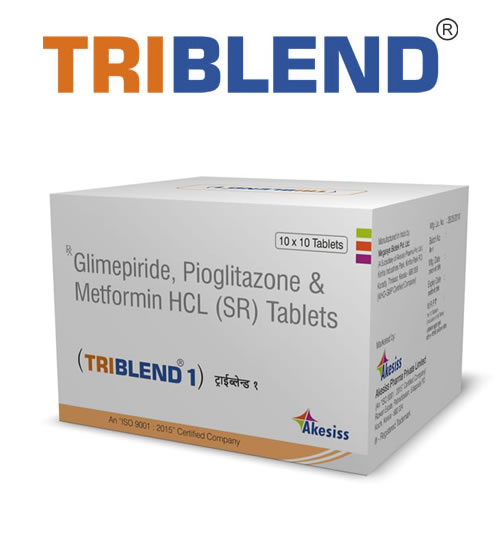COMPOSITION:
TRIBLEND 1
Each uncoated bilayer tablet contains-
Glimepiride……………………………… 1 mg
Pioglitazone ……………………………. 15 mg
Metformin (Sustain Release)……… 500 mg
TRIBLEND 2
Each uncoated bilayer tablet contains-
Glimepiride……………………………… 2 mg
Pioglitazone ……………………………. 15 mg
Metformin (Sustain Release)……… 500 mg
DESCRIPTION:
TRIBLEND contains three oral anti-hyperglycemic drugs glimepiride, pioglitazone hydrochloride, and metformin hydrochloride sustained release used in the management of type 2 diabetes (NIDDM). The primary mechanism of action of glimepiride in lowering blood glucose appears to be dependent on stimulating the release of insulin from functioning pancreatic beta cells. Pioglitazone hydrochloride is a potent and highly selective agonist for peroxisome proliferator-activated receptor-gamma (PPAR-γ). Metformin hydrochloride decreases hepatic glucose production, decreases intestinal absorption of glucose, and improves insulin sensitivity by increasing peripheral glucose uptake and utilization.
Hence, the combination of glimepiride; pioglitazone, and metformin sustained release complements each other and provides better glycaemic control in the management of Type 2 diabetes and probably in the prevention of its associated macrovascular and microvascular complications.
INDICATIONS:
TRIBLEND tablets, used as a once per day, are indicated as an adjunct to diet and exercise, to lower blood glucose. It is indicated as second-line therapy when diet, exercise, and single agents or dual therapy do not result in adequate glycaemic control in patients with type 2 diabetes.
DOSAGE:
The dosage and duration of TRIBLEND therapy should be as prescribed by a physician.
CONTRAINDICATIONS:
1. Renal disease or renal dysfunction (e.g., as suggested by serum creatinine levels 1.5 mg/dL [males], 1.4 mg/dL [females] or abnormal creatinine clearance), which may also result from conditions such as cardiovascular collapse (shock), acute myocardial infarction, and septicaemia.
2. Congestive heart failure requiring pharmacologic treatment.
3. Known hypersensitivity to this product or any of its components.
4. Acute or chronic metabolic acidosis, including diabetic ketoacidosis, with or without coma. Diabetic ketoacidosis should be treated with insulin.
5. Patients undergoing radiologic studies involving intravascular administration of iodinated contrast materials, because the use of such products may result in acute alteration of renal function.


